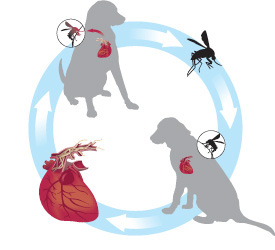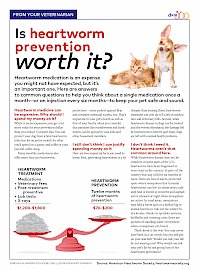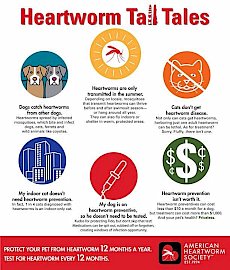Heartworms
 Heartworm is a preventable disease that is common in dogs and cats throughout the world. It is transmitted by mosquitoes, so it is worst in warm, moist areas.
Heartworm is a preventable disease that is common in dogs and cats throughout the world. It is transmitted by mosquitoes, so it is worst in warm, moist areas.
Texas is a high-risk area for heartworm disease. Since mosquitoes can get inside as well, indoor and outdoor animals are both at risk for heartworm disease. Heartworm disease can be fatal in dogs and cats. Because of this, we recommend yearly heartworm testing (a blood test) for dogs and monthly heartworm preventative (examples: Heartgard, Interceptor, Sentinel, or Revolution) for both dogs and cats.
Missed doses can mean serious consequences for pets. If you miss a dose, you should contact your veterinarian immediately for recommendations. Do not start heartworm prevention without contacting your veterinarian. A dog that is positive for heartworms is at risk for an allergic reaction if put on heartworm preventative. Adult heartworms live in the heart and large adjacent vessels of infected animals. Adult heartworms produce baby heartworms (microfilaria) which circulate in the blood. These microfilaria are picked up by mosquitoes and are passed on to unprotected dogs and cats.
What are the Clinical Signs of Heartworm Disease?
The most common signs of heartworms include coughing, difficulty breathing, exercise intolerance, weight loss, and lethargy. Pest my not show signs of heartworm disease for up to two years after infection. When the disease is recognized due to clinical signs, it is often well advanced. As the name suggests, heartworms interfere with the heart’s functions. In addition, they also cause significant problems in the lungs, liver and kidneys, which may lead to death.
Heartworm Treatment
Heartworm treatment is a serious medical procedure and can only be done in dogs. The drugs used to kill heartworms contain an arsenic component. During heartworm treatment the dog's liver and kidney will work hard to rid the dog's body of byproducts from the drugs and from the dead heartworms. Heartworm treatment carries risks to the pet. In addition, treatment is very costly. Dogs need to be kept very quiet (strict cage rest) for several weeks after heartworm treatment has been started. Because of the risks and the pain and suffering involved with heartworm treatment, it is much better to prevent heartworms in the first place. Heartworm disease can be easily prevented by giving your dog or cat a dose of heartworm preventative each month.
KEY POINTS
- Heartworms can kill your pet
- Heartworms are easily prevented
- Preventative is much cheaper than treatment – in the case of cats, there is no treatment
- Preventative should be given monthly all year round for the life of your pet
- Do not start preventative without discussing it with your veterinarian – dogs need to be tested first to prevent allergic reactions
Resources:
Click the below Images to view our Handouts
Cookies on this website are used to both support the function and performance of the site, and also for marketing purposes, including personalizing content and tailoring advertising to your interests. To manage marketing cookies on this website, please select the button that indicates your preferences. More information can be found in our privacy policy here.




